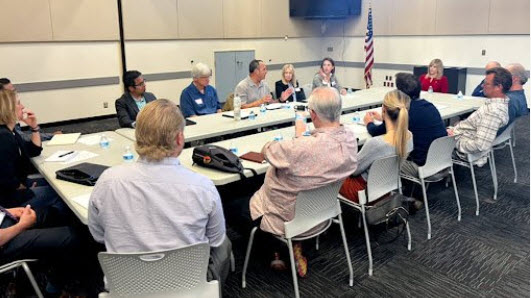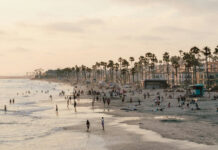Save Oceanside Sand (SOS) remains involved in all attempts to plan for a resilient Oceanside coastline. California’s 74th district State Assemblywoman Laurie Davies chaired her first Oceanside Coastal Zone invitational workshop. This initial meeting aimed to assemble the region’s concerned stakeholders so she could better understand our coastal management “Plan of Action” for future seminars.
After Representative Davies welcomed all attendees, she asked for a brief history of Oceanside beaches. She also asked for our input on what she could do to assist our efforts.
Bob Ashton from SOS started with a quote from Dr. Reinhardt Flick of Scripps Institution of Oceanography (SIO), “If you want a broad sandy beach, you must have the support and political will” He then acknowledged how we need Representative Davies’s support and political will. Ashton talked about the construction of the Del Mar Boat Basin and the Oceanside Small Craft Harbor, which created a barrier that limits the sand movement to the south. He then expressed his admiration for the large sandy beach on Camp Pendleton just north of the Del Mar Boat Basin. He also explained to the group how the sand flows down the Santa Margarita River onto the beach and is retained by the harbor jetties.
Dr. Flick spoke up and said that if we wanted a broad sandy beach, we must act now! He expressed significant frustration with having to redo all of the permitting for each Regional Beach Sand Project. Dr. Flick discussed the following:
Beach nourishment planning
Retention systems, along with monitoring and adapting each system’s Performance
Sand nourishment plan for maintenance
Repeat monitoring/adaptation/nourishment.
Retention systems will most likely require smaller or fewer nourishment events.
Getting one dredge to work all city nourishment efforts and amortize the mobilization cost.
San Onofre nuclear power plant construction had two “pads” placed nearshore that acted like retention devices for years during construction, and as soon as they were removed, the beaches disappeared.
Carlsbad’s position is “somewhat misplaced” because they have retention devices and benefit from the down drift sand that moves from Oceanside beaches.
Mitigating down drift issues by pre-filling a retention system and then maintaining the system!
It was agreed by the attendees that to get a beach retention project approved, we need to get ahead of the narrative and control the conversation. A statewide education campaign will be required to get the science known. It was also recommended that outreach such as the SOS weekend beach popups and special events with other organizations continue. Some attendees discussed cataloging all regional approved and planned projects for better coordination between cities and agencies. The meeting was summed up by all agreeing that coordinated action is required and the need for further engagement with elected officials.
Organizations represented at this meeting were as follows:
State Assemblywoman Laurie Davies & Staff
Congressman Mike Levin’s staff:
State Senator Katherine Blakespear’s Staff
Oceanside City Council & Staff
Scripps Institution of Oceanography
Resilient City Catalyst
Save Oceanside Sand


















